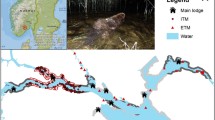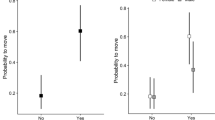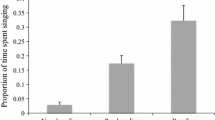Abstract
In many territorial species, occasional movements beyond territory boundaries (extraterritorial forays) have been documented in many species. While many explanations for the occurrence of extraterritorial forays have been proposed, a logical and proposed function of extraterritorial forays is to engage in extra-pair copulations with extra-pair mates outside of their territories. We used an automated radio-telemetry system (ARTS) to examine the patterns and correlates of foray behavior of male and female field sparrows (Spizella pusilla) and investigated if forays were associated with extra-pair paternity (EPP) and cuckoldry. We found that male and female field sparrows regularly engaged in extraterritorial forays. In males, age and time of foraying (day vs. night) were important factors explaining foray rates (foray/h); older (ASY) males forayed more than younger (SY) males and, while we detected many nocturnal forays, most forays occurred during the day. For females, fertility stage and age appeared to be important in explaining foray rates; older females forayed more during pre-fertile period than fertile and post-fertile periods. Unlike foray rates, the duration of forays (min) was not explained by any of the variables examined. Surprisingly, despite the large number of forays documented (>3500), greater foray rates or duration of forays were not associated with higher probability of EPY for males or females or with cuckoldry in males. Forays may play a role in prospecting and acquiring information about their social and ecological environment, which ultimately may help them to achieve greater reproductive success, but not necessarily in the form of EPP.
Significance statement
Despite many territorial species are known to conduct extraterritorial forays (movements beyond their territory), very little is known about this behavior. We used an automated radio-telemetry system (ARTS) to examine the patterns, correlates, and paternity consequences of extraterritorial foray behavior in male and female field sparrows (Spizella pusilla). We documented more than 3500 forays and found that both male and female field sparrows regularly engaged in extraterritorial forays; however, different factors explain their foray rates (age, time of foraying (day vs. night), and fertility stage) but not the duration of forays. Surprisingly, greater foray rates or duration of forays were not associated with higher probability of EPY in males or females or with cuckoldry in males. Rather than exclusively acquiring extra-pair matings, forays likely serve multiple purposes, such as prospecting and acquiring information about their social and ecological environment, which ultimately may help individuals achieve greater reproductive success.





Similar content being viewed by others
References
Akçay E, Searcy WA, Campbell SE, Reed VA, Templeton CN (2012) Who initiates extrapair mating in song sparrows? Behav Ecol 23:44–50
Anderson DR (2008) Model based inference in the life sciences: a primer on evidence. Springer, New York
Arnold TW (2010) Uninformative parameters and model selection using Akaike’s information criterion. J Wildlife Manage 74:1175–1178
Arnold SJ, Duvall D (1994) Animal mating systems: a synthesis based on selection theory. Am Nat 143:317–348
Barron DG, Webster MH, Schwabl H (2015) Do androgens link morphology and behavior to produce phenotype-specific behavioural strategies? Anim Behav 1010:116–124
Best LB (1977) Territory quality and mating success in the field sparrow (Spizella pusilla). Condor 79:192–204
Betts MG, Hadley AS, Rodenhouse N, Nocera JJ (2008) Social information trumps vegetation structure in breeding-site selection by a migrant songbird. Proc R Soc Lond B 275:2257–2263
Birkhead TR, Møller AP (1992) Sperm competition in birds. Academic Press, London
Brown JL (1964) The evolution of diversity in avian territorial systems. Wilson Bull 76:160–169
Brown JL (1969) Territorial behavior and population regulation in birds. Wilson Bull 81:293–329
Burnham KP, Anderson DR (2002) Model selection and multimodel inference: a practical information-theoretic approach. Springer, New York
Burnham KP, Anderson DR, Huyvaert KP (2010) AICc model selection in the ecological and behavioral sciences: some background, observations and comparisons. Behav Ecol Sociobiol 65:23–35
Canales-Delgadillo JC, Scott-Morales L, Niehuis O, Korb J (2010) Isolation and characterization of nine microsatellite loci in the endangered Worthen’s sparrow (Spizella wortheni). Conserv Genet Resour 2:151–153
Carey M, Burhans DE, Nelson DA (1994) Field sparrow (Spizella pusilla). In: Poole A,Gill F (eds) The birds of North America, No. 103. The Academy of Natural Sciences, Philadelphia, Pennsylvania and The American Ornithologists’ Union, Washington, DC
Celis-Murillo A, Stodola KW, Pappadopoli B, Burton JM, Ward MP (2016a) Seasonal and daily patterns of nocturnal singing in the field sparrow (Spizella pusilla). J Ornithol . doi:10.1007/s10336-015-1318-ypublished online
Celis-Murillo A, Benson TJ, Sosa-Lopez R, Ward MP (2016b) Nocturnal songs in a diurnal passerine: attracting mates or repelling intruders. Anim Behav 118:105–114
Chiver I, Stutchbury BJM, Morton ES (2008) Female foray behaviour correlates with male song and paternity in a socially monogamous bird. Behav Ecol Sociobiol 62:1981–1990
Churchill JL, Hannon SJ (2010) Off-territory movement of male American redstarts (Setophaga ruticilla) in a fragmented agricultural landscape is related to song rate, mating status and access to females. J Ornithol 151:33–44
Dakin EE, Avise JC (2004) Microsatellite null alleles in parentage analysis. Heredity 93:504–509
Dale S, Amundsen T, Lifjeld TJ, Slagsvold T (1990) Mate sampling behavior of female pied flycatchers: evidence for activemate choice. Behav Ecol Sociobiol 27:87–92
Dalziell AH, Cockburn A (2008) Dawn song in superb fairy-wrens: a bird that seeks extra-pair copulations during the dawn chorus. Anim Behav 75:489–500
Danchin E, Heg D, Doligez B (2001) Public information and breeding habitat selection. In: Clobert J, E. Danchin E, Dhondt AA, Nichols J (eds) Dispersal. Oxford University Press, Oxford, pp 243–258
Deppe JL, Ward MP, Bolus R et al (2015) Negotiating the Gulf of Mexico: fat, weather, and date affect migratory songbirds’ departure decisions, routes, and crossing times. P Natl Acad Sci USA 112:E6331–E6338
Doligez B, Pärt T, Danchin E (2004) Prospecting in the collared flycatcher: gathering public information for future breeding habitat selection? Anim Behav 67:457–466
Double M, Cockburn A (2000) Pre-dawn infidelity: females control extra-pair mating in superb fairy-wrens. Proc R Soc Lond B 267:465–470
Duval EH, Kappor JA (2015) Causes and consequences of variation in female mate search investment in a lekking bird. Behav Ecol 26:1537–1547
Eadie JM, Gauthier G (1985) Prospecting for nest sites by cavity-nesting ducks of the genus Bucephala. Condor 87:528–534
Evans ML, Stutchbury BJM, Woofenden BE (2008) Off-territory forays and the genetic mating system of the wood thrush. Auk 125:67–75
Fossøy F, Johnsen A, Lifjeld JT (2006) Evidence of obligate female promiscuity in a socially monogamous passerine. Behav Ecol Sociobiol 60:255–259
Giraldeu LA (1997) The ecology of information use. In: Krebs JR, Davis NB (eds) Behavioural ecology. Blackwell Scientific, Oxford, pp 42–68
Griffith SC, Owens IPF, Thuman KA (2002) Extra pair paternity in birds: a review of interspecific variation and adaptive function. Mol Ecol 11:2195–2212
Gross MR (1996) Alternative reproductive strategies and tactics: diversity within sexes. Trends Ecol Evol 11:92–98
Grueber CE, Nakagawa S, Laws RJ, Jamieson IG (2011) Multimodel inference in ecology and evolution: challenges and solutions. J Evol Biol 24:699–711
Hoeschele MMK, Moscicki KA, van Oort H, Fort KT, Farrell TM, Lee H, Robson SWJ, Sturdy CB (2010) Dominance signaled in acoustic ornament. Anim Behav 79:657–664
Humbird SK, Neuford DLH (2008) The effects of food supplementation on extraterritorial behavior in female northern cardinals. Condor 110:392–395
Hunter FM, Burke T, Watts SE (1992) Frequent copulation as a method of paternity assurance in the northern fulmar. Anim Behav 44:149–156
Jennions MD, Petrie M (1997) Variation in mate choice and mating preferences: a review of causes and consequences. Biol Rev 72:283–327
Kalinowski ST, Taper ML, Marshall TC (2007) Revising how the computer program CERVUS accommodates genotyping error increases success in paternity assignment. Mol Ecol 16:1099–1106
Kays R, Tilak S, Crofoot M, Fountain T, Obando D, Ortega A (2011) Tracking animal location and activity with an automated telemetry system in a tropical rainforest. Comput J 54:1931–1948
Keating KA, Cherry S (2009) Modeling utilization distributions in space and time. Ecology 90:1971–1980
Kempenaers B, Dhondt AA (1993) Why do females engage in extra-pair copulations? A review of hypotheses and predictions. Belg J Zool 123:93–103
Kempenaers B, Verheyren GR, Dhondt AA (1997) Extrapair paternity in the blue tit (Parus caeruleus): female choice, male characteristics, and offspring quality. Behav Ecol 8:481–492
Kleven O, Marthinsen G, Lifjeld JT (2006) Male extraterritorial forays, age and paternity in the socially monogamous reed bunting (Emberiza schoeniclus). J Ornithol 147:468–473
Kranstauber B, Kays R, LaPoint SD, Wikelski M, Safi K (2012) A dynamic Brownian bridge movement model to estimate utilization distributions for heterogeneous animal movement. J Anim Ecol 81:738–746
Lemon RE, Weary DM, Norris KJ (1992) Male morphology and behavior correlate with reproductive success in the American redstart (Setophaga ruticilla). Behav Ecol Sociobiol 29:399–403
Littell RC, Milliken GA, Stroup WW, Wolfinger RD, Schabenberger O (2006) SAS for mixed models, 2nd edn. SAS Institute Inc, Cary, NC
Maness TJ, Anderson DJ (2008) Mate rotation by female choice and coercive divorce in Nazca boobies, Sula granti. Anim Behav 76:1267–1277
Marshall TC, Slate J, Kruuk LEB, Pemberton JM (1998) Statistical confidence for likelihood-based paternity inference in natural populations. Mol Ecol 7:639–655
Mays HL, Hill GE (2004) Choosing mates: good genes versus genes that are a good fit. Trends Ecol Evol 19:554–559
Naguib M, Altenkamp R, Griebmann B (2001) Nightingales in space: song and extra-territorial forays of radio tagged song birds. J Ornithol 142:306–312
Neudorf DL, Stutchbury BJM, Piper WH (1997) Covert extraterritorial behavior of female hooded warblers. Behav Ecol 8:595–600
Pärt T (1995) The importance of local familiarity and search costs for age- and sex-biased philopatry in the collared flycatcher. Anim Behav 49:1029–1038
Pärt T, Doligez B (2003) Gathering public information for habitat selection: prospecting birds cue on parental activity. Proc R Soc Lond B 270:1809–1813
Pärt T, Arlt D, Doligez B, Low M, Qvarnström A (2011) Prospectors combine social and environmental information to improve habitat selection and breeding success in the subsequent year. J Anim Ecol 80:1227–1235
Patrick SC, Chapman JR, Dugdale HL, Quinn JL, Sheldon BC (2012) Promiscuity, paternity and personality in the great tit. Proc R Soc Lond B B279:1724–1730
Pedersen MC, Dunn PO, Whittingham LA (2006) Extraterritorial forays are related to a male ornamental trait in the common yellowthroat. Anim Behav 72:479–486
Petter SC, Miles DB, White MW (1990) Genetic evidence of mixed reproductive strategy in a monogamous bird. Condor 92:702–708
Pitcher TE, Stutchbury BJM (2000) Extraterritorial forays and male parental care in hooded warblers. Anim Behav 59:1261–1269
Pyle P (1997) Identification guide to north American birds, part 1. Slate Creek Press, Bolinas, CA
R Development Core Team (2008) R: a language and environment for statistical computing. R Foundation for Statistical Computing, Vienna http://www.R-project.org, Urbana, USA
Raim A (1978) A radio transmitter attachment for small passerine birds. Bird Band 49:326–332
Rintamaki PT, Alatalo RV, Hoglund J, Lundberg A (1995) Male territoriality and female choice on black grouse leks. Anim Behav 49:75–767
Roth T, Sprau P, Schmidt R, Naguib M, Amrhein V (2009) Sex-specific timing of mate searching and territory prospecting in the nightingale: nocturnal life of females. Proc R Soc Lond B 276:2045–2050
Rousset F (2008) Genepop’007: a complete re-implementation of the genepop software for Windows and Linux. Mol Ecology Resour 8:103–106
Schjørring S, Gregersen J, Bregnballe T (1999) Prospecting enhances breeding success of first-time breeders in the great cormorant, Phalacrocorax carbo sinensis. Anim Behav 57:647–654
Schuett W, Tregenza T, Dall SRX (2010) Sexual selection and animal personality. Biol. Rev. 85:217— 246
Sellaeg DE (2014) Inferring female extra-pair mating behaviour from observed patterns of extra-pair paternity with a process-based model. The University of Bergen, Bergen, Norway, MSc thesis
Seutin G, White BN, Boag PT (1991) Preservation of avian blood and tissue samples for DNA analyses. Can J Zool 69:82–90
Sherman PW, Morton ML (1988) Extra-pair fertilizations in mountain white-crowned sparrows. Behav Ecol Sociobiol 22:413–420
Silverman BW (1986) Density estimation for statistics and data analysis. Chapman and Hall, Urbana, USA
Staiger SS, Valcu M, Spoelstra K, Helm B, Wikelski M, Kempenaers B (2013) When the sun never sets: diverse activity rhythms under continuous daylight in free-living Arctic-breeding birds. Proc R Soc B 280:20131016
Strausberger BM, Ashley MV (2001) Eggs yield nuclear DNA from egg-laying female cowbirds, their embryos and offspring. Conserv Genet 2:385–390
Strausberger BM, Ashley MV (2003) Breeding biology of brood parasitic brown-headed cowbirds (Molothrus ater) characterized by parent-offspring and sibling-group reconstruction. Auk 2:433–445
Stutchbury BJM, Piper WH, Neudorf DL, Tarof SA, Rhymer JM, Fuller G, Fleischer RC (1997) Correlates of extra-pair fertilization success in hooded warblers. Behav Ecol Sociobiol 40:119–126
Stutchbury BJM, Pitcher TE, Norris DR, Tuttle EM, Gonsar RA (2005) Does male extra-territory foray effort affect within and extra-pair fertilization success in hooded warblers. J Avian Biol 36:471–477
Symonds MRE, Musalli A (2011) A brief guide to model selection, multimodel inference and model averaging in behavioural ecology using Akaike’s information criterion. Behav Ecol Sociobiol 65:13–21
Walk JW, Kershner EL, Wagner RE (2000) Nocturnal singing in grassland birds. Wilson Bull 112:289–292
Ward MP, Sperry JH, Weatherhead PJ (2013) Evaluation of automated telemetry for quantifying movements and home ranges of snakes. J Herpetol 47:337–345
Ward MP, Alessi M, Benson TJ, Chiavacci SJ (2014) The active nightlife of diurnal birds: extraterritorial forays and nocturnal activity patterns. Anim Behav 88:175–184
Weatherhead PJ, Boag PT (1995) Pair and extra-pair mating success relative to male quality in red-winged blackbirds. Behav Ecol Sociobiol 37:81–91
Weatherhead PJ, Montgomerie R, Gibbs HL, Boag PT (1994) The cost of extra-pair fertilizations to female red-winged blackbirds. Proc R Soc Lond B 258:315–320
Westneat DF (1988) Male parental care and extrapair copulations in the indigo bunting. Auk 105:149–160
Westneat DF, Stewart IRK (2003) Extra-pair paternity in birds: causes, correlates, and conflict. Annu Rev Ecol Syst 34:365–396
Yasui Y (1998) The ‘genetic benefits’ of multiple mating reconsidered. Trends Ecol Evol 13:246–250
Yasui Y (2001) Female multiple mating as a genetic bet-hedging strategy when mate choice criteria are unreliable. Ecol Res 16:605–616
Yezerinac SM, Weatherhead PJ (1997) Extra-pair mating, male plumage coloration, and selection in yellow warblers (Dendroica petechia). Proc R Soc Lond B 264:527–532
Acknowledgments
We thank Jeff Brawn, Andy Suarez, and two anonymous reviewers for their comments on previous drafts of the manuscript. We thank Devin Kerr, Eric Swenson, Jessica Burton, Brian Pappadopoli, Zara John, Sarah Tomke, Ben Neece, Victor Zhang, Jonathon Jackson, Jill Deppe, Kyle Van den Bosch, and Scott Chiavacci for their help in the field and laboratory. We also thank the Vermilion County Conservation District for permission to conduct research at Kennekuk Cove County Park.
Author information
Authors and Affiliations
Corresponding author
Ethics declarations
Funding
The National Science Foundation (DDIG-14070801), Animal Behavior Society Student Research Grant, American Ornithologist Union Research Award, Illinois Ornithological Society Grants, Department of Natural Resources and Environmental Sciences travel awards, University of Illinois at Urbana-Champaign student opportunity grants, and the Illinois Department of Natural Resources (W-154-R-6).
Conflict of interest
The authors declare that they have no conflict of interest.
Ethical approval
All procedures performed were in accordance with the ethical standards of the University of Illinois’ Institutional Animal Care and Use Committee under the IACUC protocol #10127 and the USGS bird banding permit (23577).
Informed consent
Informed consent was obtained from all individual participants included in the study.
Additional information
Communicated by J. A. Graves
Electronic supplementary material
ESM 1
(DOCX 27 kb)
Rights and permissions
About this article
Cite this article
Celis-Murillo, A., Schelsky, W., Benson, T.J. et al. Patterns, correlates, and paternity consequences of extraterritorial foray behavior in the field sparrow (Spizella pusilla): an automated telemetry approach. Behav Ecol Sociobiol 71, 45 (2017). https://doi.org/10.1007/s00265-017-2273-9
Received:
Revised:
Accepted:
Published:
DOI: https://doi.org/10.1007/s00265-017-2273-9




